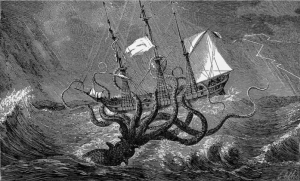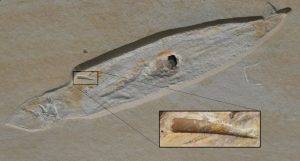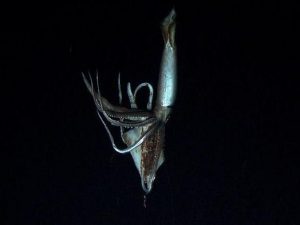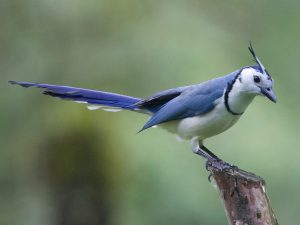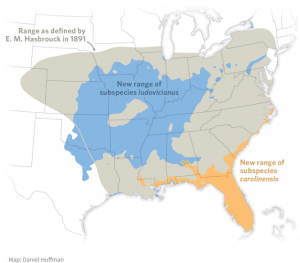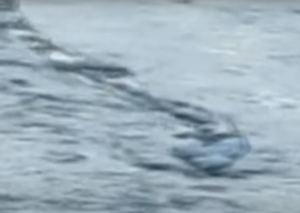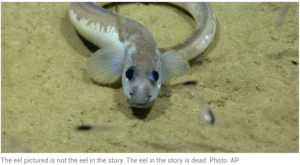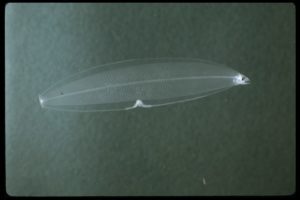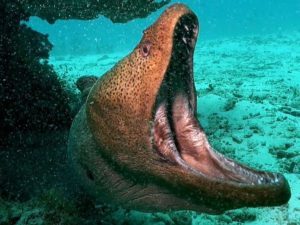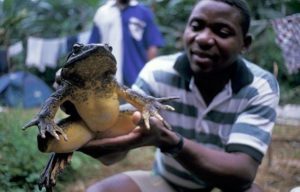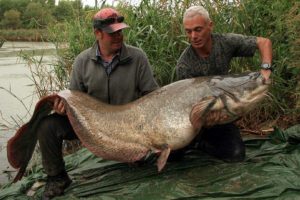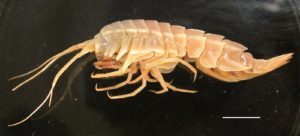Podcast: Play in new window | Download (Duration: 24:25 — 25.2MB)
Subscribe: | More
This week we investigate a couple of famous lake monsters, Nessie and Champ. Don’t worry, there are more lake monster and sea monster episodes coming in the future!
Most lake monster pictures look like this. Compelling! This was taken in Loch Ness:
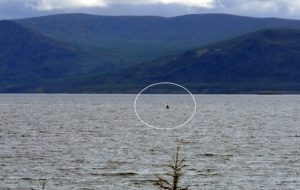
The famous Mansi photograph taken in Lake Champlain:
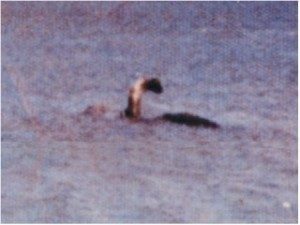
Beluga whales are really easy to spot. Look, this one has a soccer ball!

Further reading:
Hunting Monsters by Darren Naish
Abominable Science! by Daniel Loxton and Donald R. Prothero
Show transcript:
Welcome to Strange Animals Podcast. I’m your host, Kate Shaw.
Back in March, we released an episode about sea monsters. For a long time it was our second most downloaded show, behind the ivory-billed woodpecker, although the jellyfish and shark episodes have taken over the top spots lately. I always intended to follow up with an episode on lake monsters, so here it is.
Let me just say going in that I think most lake monster sightings are not of unknown animals. On the other hand, I also firmly believe there are plenty of unknown animals in lakes—but they’re probably not very big, probably not all that exciting to the average person, and probably not deserving of the name monster. But who knows? I’d love to be proven wrong. Let’s take a look at what people are seeing out there.
One of the biggest names in cryptids is Nessie, the Loch Ness Monster. She and Bigfoot are the superstars of cryptozoology. But despite almost a century of close scrutiny of Loch Ness, we still have no proof she exists.
Loch Ness is the biggest of a chain of long, narrow, steep-sided lakes and shallow rivers that cut Scotland right in two along a fault line. Loch Ness is 22 miles long with a maximum depth of 754 feet, the biggest lake in all of the UK, not just Scotland. It’s 50 feet above sea level and was carved out by glaciers. During the Pleistocene, Scotland was completely covered with ice half a mile deep until about 18,000 years ago. And before you ask, plesiosaurs disappeared from the fossil record 66 million years ago.
Loch Ness isn’t a remote, hard to find place. All the lochs and their rivers have made up a busy shipping channel since the Caledonian Canal made them more navigable with a series of locks and canals in 1822, but the area around Loch Ness was well populated and busy for centuries before that. Loch Ness has long been a popular tourist destination, well before the Nessie sightings started. There have been stories of strange creatures in Loch Ness and all the lochs, but nothing that resembles the popular idea of Nessie. Rather, the stories were of water monsters of Scottish folklore like the kelpie, or of out-of-place known animals like a six-foot bottle-nosed dolphin that was captured at sea and released in the loch as a prank in 1868.
Then, in August of 1933 a couple on holiday from London, Mr. and Mrs. George Spicer, reported seeing a quote “dragon or prehistoric animal” unquote crossing the road 50 yards or so in front of their car near the loch. Mr. Spicer said quote “It seemed to have a long neck which moved up and down, in the manner of a scenic railway, and the body was fairly big, with a high back.” unquote. The creature was gray and seemed to be carrying a lamb or other animal at its shoulder. Spicer described it as 25 to 30 feet long, with no feet or tail visible although Spicer said he thought the tail must be curved around behind the body.
You know what else happened in 1933? King Kong was released in April of that year. If you haven’t seen the movie, or haven’t seen it in a long time, there’s a long-necked dinosaur in the movie that overturns a raft and kills the men aboard. The movie was a sensation unlike anything today, and that dinosaur looks identical to what George Spicer described seeing, right down to the details of the hidden feet, tail curved behind the body, and even the lamb or other animal it was carrying, since in the movie, the monster plucks a man from a tree and shakes him in its mouth at precisely the angle Spicer describes. In fact, Spicer admitted in an interview a few months after his sighting that he had seen King Kong and that his monster strongly resembled the dinosaur in the movie.
Spicer’s story hit the newspapers and spawned dozens of similar reports, along with a huge influx of tourists hoping to see the monster. Locals took advantage of the situation by branding everything in sight with Nessie, from beach toys to floor polish. By 1934 Nessie had appeared in a talkie called The Secret of the Loch, not to mention in radio shows, cartoons, popular songs, and basically everything. Her popularity hasn’t faded since.
One good thing has come from Nessie’s popularity. Loch Ness has been studied far more than it would have been otherwise. The water is murky with low visibility, so underwater cameras aren’t much use. However, submersibles with cameras attached have been deployed many times in the loch. In 1972 a dramatic result was reported, with a clearly diamond-shaped flipper photographed from a submersible, but it turned out that the flipper was basically painted onto two photos that otherwise show nothing but the reflection of light on silt or bubbles. Sonar scanning has been done on the entire lake repeatedly, in 1962, 1968, 1969, twice in 1970, 1981 through 1982, 1987, and 2003. They found no gigantic animals. The 1987 scan resulted in three hits of something larger than the biggest known salmon in the loch, but much smaller than a lake monster. It’s possible that the hits were only debris such as sunken boats or logs. From all the scans, though, we know there are no hidden outlets to the sea under the lake’s surface.
There are lots of known animals in and around the loch, from salmon to otters, and lots and lots of birds. Seals frequently visit, coming up the shallow River Ness through its locks. Any of these animals, especially the seals, may have contributed to Nessie sightings over the years, together with boats seen in the distance and floating debris such as logs. The lake doesn’t contain enough fish to sustain a population of large mystery animals even if they had somehow eluded all those sonar scans. No bones or dead bodies have been found, and no clear photographs have ever been taken of an unknown animal.
So that’s that. Sorry, Nessie. But what about other lake monsters?
Lake Champlain between New York and Vermont in the United States and part of Quebec in Canada, is supposedly home to a monster called Champ. Lake Champlain is bigger than Loch Ness but not as deep, around 125 miles long but no more than 14 miles wide at any point, and only about 400 feet deep. Like Loch Ness, it’s above sea level, in this case around 100 feet above. In summer the water is warm, while in winter part or even all of the lake may freeze over.
Lake Champlain has been around in one form or another for about 200 million years, when a big chunk of bedrock fell into a fissure between two faults, forming a canyon that filled with water from streams. Around 3 million years ago during the Pleistocene—that’s the ice age, remember—the entire region was covered with a mile-thick sheet of ice.
Ice is heavy, and since the continental ice sheets sat on the area for three million years, their weight pressed the rock down so that it was below sea level. When the ice melted around 12,000 years ago, it took a few thousand years before the rocks rose to their current levels—a process known as isostatic rebound. Between the time the ice sheets stopped blocking the ocean to the time the area rose above sea level, waters from the Atlantic flowed in and formed a shallow inland sea. Geologists call it the Champlain Sea.
The Champlain Sea was only around for about 2,000 years, and while it was connected to the Atlantic, the water wasn’t as salty as the ocean since there was so much runoff from melting glaciers. The sea shrank steadily as the land rose, until finally the ocean inlet was cut off. Fresh water flushed out the salt, creating the lake we see today.
The lake is home to a lot of genuinely big fish, including sturgeon, salmon, gar, pike, and some introduced game fish species like European carp. Naturally it’s a busy lake, with lots of anglers and tourists. Even the shipwrecks are a tourist draw, with divers required to register yearly for permission to explore the wrecks.
Many people quote Samuel de Champlain’s 1609 journal entry as the first sighting of the monster. But the famous quote about a 20-foot serpent thick as a barrel is a fake published in the summer 1970 issue of Vermont Life. A genuine quote from Champlain’s journal is less monstery. It’s clear he’s talking about a fish. Here’s the quote: “[T]here is also a great abundance of many species of fish. Amongst others there is one called by the natives Chaousarou, which is of various lengths; but the largest of them, as these tribes have told me, are from eight to ten feet long. I have seen some five feet long, which were as big as my thigh, and had a head as large as my two fists, with a snout two feet and a half long, and a double row of very sharp, dangerous teeth. Its body has a good deal the shape of the pike; but it is protected by scales of a silvery gray colour and so strong that a dagger could not pierce them.”
This description is probably that of the longnose gar, which can grow over six feet long and has a lot of sharp teeth in a very long jaw. It’s usually brownish or greenish but can appear silvery in color, and it has overlapping scales that are quite thick.
Whatever Champlain was talking about, it wasn’t Champ. It’s not until 1819 that a real monster is reported in the lake. The account appeared in the July 24, 1819 newspaper the Plattsburgh Republican, and is an account of a Captain Crum from a few days before. I looked up the original, which is available online in a pretty good scan—I could read the whole article except for one word—and guess what? It’s not real. It’s not even a hoax. It’s just one of those jokey space-fillers from back in the olden days when everyone apparently had the same sense of humor found in old Reader’s Digests. It’s short so I’m just going to quote you the whole dang thing exactly as it appears.
Mr. Printer,
On Thursday last, the inhabitants on the shore of Bulwagga Bay, were alarmed by the appearance of a monster, which from the description must be a relation of the Great Sea Serpent.
Captain Crum, who witnessed the sight, relates that about eight o’clock in the morning when putting out from shore in a scow, he discovered at a distance of not more than two hundred yards, an unusual undulation of the surface of the water, which was somethinged by the appearance of a monster rearing its head more than fifteen feet and moving with the utmost velocity to the south—at the same time lashing with its Tail two large Sturgeon and a Bill-fish which appeared to be engaged in pursuit. After the consternation occasioned by such a terrific spectacle had subsided, Capt. Crum took a particular survey of this singular animal, which he describes to be about 187 feet long, its head flat with three teeth, two in the under and one in the upper jaw, in shape similar to the sea-horse—the color black, with a star in the forehead and a belt of red around the neck—its body about the size of a hogshead with bunches on the back as large as a common potash barrel—the eyes large and the color of a pealed onion. He continued to move with astonishing rapidity towards the shore for about a minute, when suddenly he darted under water and has not since been seen, altho’ many fishing boats have been on the look out. Capt. Crum informs me that he has sent an express to Capt. Rich, of Boston, communicating this intelligence, but is fearful that before his arrival this disturber of our waters may be changed to a pickerel. Mr. *******, the celebrated engraver of the Battle of Plattsburgh, is now at this place, prepared to take a sketch of his terrific majesty, should he again make his appearance.
I am, sir, with great respect,
your ob’t serv’t.
HORSE MACKEREL.
HORSE MACKEREL, SIR, HORSE MACKEREL
It isn’t until 1873 that some seemingly real sightings show up. During that year there were two reports of a water serpent—estimated by one witness, a sheriff, at around 30 feet. The idea of a lake monster began to gain traction. PT Barnum even offered a reward for the monster’s skin.
The best evidence for Champ’s existence is a 1977 photo taken by Sandra Mansi. She and her family had stopped by the lake and her kids were paddling in the shallows when Mansi spotted the monster. She says she was terrified and rushed to get her children out of the water, but she took one picture. But she didn’t show the photo to anyone until 1981 when a friend pointed out how important it was. By then the negative was lost.
I’ll put the picture in the show notes. At first glance it’s stunning, clearly showing a monster with a slender neck curved away from the viewer, its skin gleaming with water in the sun. Part of its sloped back is visible above the water. Its head is small and in shadow.
But look more closely and things start to appear less clear. The photo is grainy, without a lot of detail. There appears to be something else in the water near the monster’s neck, far enough away and of such size that it can’t be a flipper or tail, but the same color as the monster. There’s also a little bump at the base of the monster’s neck that doesn’t look very biological. It almost looks like a root.
General consensus, and I agree, is that the picture shows nothing more exciting than a half-submerged tree stump with one curved root sticking up out of the water. And Mansi’s story doesn’t hold up either. For a long time she claimed she couldn’t remember where the picture was taken although she’s familiar with the area, but in more recent interviews she says she’s withholding information about the site so no one could find and kill the monster. She claims she never kept photo negatives—in his excellent book Hunting Monsters, Darren Naish calls this “a peculiar habit,” but back before digital cameras I never kept negatives either. But Mansi’s husband said in an interview that that particular negative had been specifically destroyed—either burnt or buried—because of the bad feelings Mansi had about the encounter. Since Mansi claimed at various times that the photo itself was either in an album or actually hung in the kitchen, she can’t have been too upset about it. If she was upset, why didn’t she destroy the picture at the same time as the negative?
Various people have pinpointed the spot where the picture was taken. It’s in Missiquoi Bay, which is no more than 14 feet deep, and the spot where the monster appears in the photo is only six feet deep with a fast current. In other words, a big lake monster is unlikely to be swimming in such shallow water, but a tree stump with roots might be tumbled there by the current.
There are plenty of other photos and videos taken at the lake, none of them convincing. But there is a mystery associated with the lake that may or may not have anything to do with Champ. I mentioned this in our strange recordings episode, episode eight. Squeaks, squeals, and loud clicking that sounds like echolocation was recorded underwater in Lake Champlain in 2003 by the Discovery Channel and in 2014 by local Champ enthusiasts. Fish-finding sonar and other artificial sources have been ruled out due to the irregularities in the sounds. In March 2010 the article “Echolocation in a fresh water lake” appeared in the Journal of the Acoustical Society of America, written by Elizabeth von Muggenthaler. The journal is about the field of acoustics, not a biological studies journal. Recent articles include one about laser-driven hearing aids, one about soundscape evaluations, and others that are so technical I don’t even know what they’re talking about, like “Solving transient acoustic boundary value problems with equivalent sources using a lumped parameter approach.” It’s not about whales, at least. On the other hand, Von Muggenthaler is a bioacoustician who was part of the Discovery Channel scientific team that recorded the clicking in 2003. Her work includes discoveries in infrasound made by giraffes and rhinos. She returned to Lake Champlain in 2009 for further research, although I haven’t discovered any reports of their findings.
The 2003 recording has been examined by Dr. Lance Barret Lennard, head of the cetacean research program at Vancouver aquarium. He doesn’t think the sounds are mammalian in origin and has doubts that they’re echolocation. But that doesn’t mean they aren’t being made by an animal. Around the same time as the Discovery Channel recordings but on the other side of the world, Snake-neck turtles in Australia were discovered to be making underwater percussive sounds that resemble echolocation as well as squeaks, chirps, and many other noises.
A lot of people think the 2003 and 2014 Lake Champlain recordings sound like beluga whales. We know whales and other marine animals lived in the Champlain Sea because we’ve found their remains, but whales can’t survive long in fresh water and even if they could, they’d be easily spotted when they came up to breathe. Beluga whales in particular are easily identified since they have round white heads that look like big eggs popping up to the surface of the water. But what if something else, something unknown, lived in the Champlain sea and stayed there after its access to the Atlantic was cut off? What if it was able to tolerate the increasingly freshening water and lives there still?
This would be awesome. It might also explain the clicking sounds recorded in the lake. But don’t forget how busy this lake is. Whatever unknown animal might be hiding in the lake, it simply can’t be gigantic, no matter how shy. We’d have definitive proof by now, probably by an astonished fisherman who hauled it up on his line, or a body washed ashore like the 7-foot sturgeon found in August of 2016, dead of natural causes. A diver might have seen it, or a commercial fisherman running sophisticated sonar.
My guess is the clicking is made by a fish, reptile, or maybe an amphibian that’s already known to science, but no one realizes it makes these noises. Whatever animal makes it, and whether or not it’s actual echolocation, it’s exciting. If I was in charge of investigations into the recordings, I’d take a good hard look at what might be hiding in the mud, especially turtles. I’d also order pizza for the team every night! And donuts with sprinkles! Good work, team.
Here’s a sample of the squeaks and clicks recorded in 2014.
[clicking]
We’d be here all night and day if I were to go over every lake monster ever reported. Almost every body of water has its own monster. I grew up near Norris Lake, which was formed in the 1930s when the Clinch River was dammed by the Tennessee Valley Authority. When I was a kid, it was “common knowledge” that there were catfish at the base of the dam as big as VW Bugs. Yeah, I don’t think so. But stories of monstrous fish, huge water snakes, and gigantic unidentified reptilian creatures are a staple of local legends everywhere. We want to tell scary stories about what might be under the water! That doesn’t mean there aren’t monsters out there, but it also doesn’t mean every story is true.
The problem with lake monsters is twofold. Firstly, a lake is a confined body of water. It’s not like the ocean, where any number of huge creatures can hide completely unknown to humans except for rare chance encounters. Even a big lake has limited space and resources compared to the ocean. A small lake simply can’t support a viable breeding population of giant animals, and since lakes are usually well populated by humans, it’s impossible to imagine that anything large living in the water wouldn’t be seen clearly and regularly by boaters and locals—not to mention that it would impact the ecology of its lake, which would definitely be noted by researchers.
Secondly, the reports we do have don’t make up a clear picture of one type of unknown animal. This sighting talks about a long-necked dinosaur-like monster crossing the road, but this other sighting describes a serpentine monster swimming in the lake, while a third sighting is just a triangular head or fin visible above the water. They can’t all three be the same animal, but one small lake simply can’t support three gigantic animals.
It’s clear, then, that a lot of the genuine sightings (that is, ones that aren’t hoaxes) have to be of known animals or floating debris that witnesses misidentified. This is just plain human nature, too. If you’re visiting Loch Ness or Lake Champlain, you’re undoubtedly familiar with the local stories—honestly, you can’t not be familiar with them. Nessie and Champ are local mascots. If you then spot something strange in the water, your first thought is that you’ve seen the monster. Later you might think it over and realize maybe that was just a big sturgeon at the surface. But by then your monster sighting has made it into the papers and onto the cryptozoological websites as genuine.
That said, I’m totally open to the possibility of unknown animals hiding in lakes. New species are discovered all the time—most of them small, but sometimes we get surprises. A new species of freshwater stingray was discovered a few years ago in Brazil, and it’s four feet long.
It’s pretty clear that I need to revisit lake monsters in a future episode, just as I have plans to explore sea monsters again. There’s just too much to cover in one episode. But that’s it for now. Until next week, keep your ears open for weird clicking sounds and if anyone is rude to you, feel free to shout, “HORSE MACKEREL, SIR”. I know I’m going to.
You can find Strange Animals Podcast online at strangeanimalspodcast.com. We’re on Twitter at strangebeasties and have a facebook page at facebook.com/strangeanimalspodcast. If you have questions, comments, or suggestions for future episodes, email us at strangeanimalspodcast@gmail.com. If you like the podcast and want to help us out, give us a rating and review on iTunes or whatever platform you listen on. We also have a Patreon if you’d like to support us that way. Rewards include exclusive twice-monthly episodes and stickers.
Thanks for listening!
